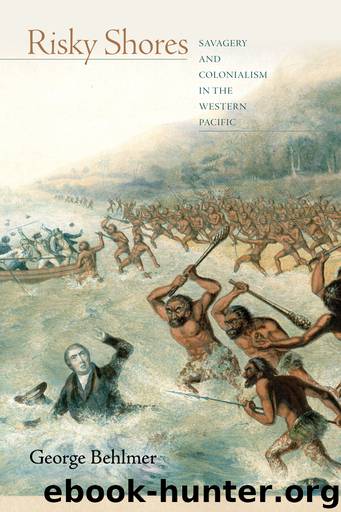Risky Shores by Behlmer George K

Author:Behlmer, George K. [Behlmer, George K.]
Language: eng
Format: epub
Publisher: Stanford University Press
Published: 2018-03-14T16:00:00+00:00
Figure 4.2 Tree house, Ysabel, Solomon Islands, early 1880s. Retractable rattan ladders offered some protection against headhunting raids. Once the raiders acquired rifles, however, these aeries became death traps.
SOURCE: Walter Coote, The Western Pacific (1883).
Relations between traders and the archipelago’s headhunting people were likewise fraught. Contrary to the enduring image of the Pacific trader as a libidinous lout whose lucre came from swindling clueless Islanders, in the Solomons these gamblers led hard lives. Few realized handsome profits. They were beholden to the Sydney merchants who expected strong returns on the capital they lent them to buy trade stock. When prices dropped abroad for tropical products, it was the lone trader who sustained most of the loss.87 Solomon Island traders tried to play one native settlement against another. Nor did traders maintain a united front among themselves. Norman Wheatley, an entrepreneur based at New Georgia’s Roviana Lagoon, withheld information about the Bulani village people who had snatched the heads of two European competitors, David Kerr and John Smith of the ketch Amelia. Had Wheatley helped the Royal Navy punish those responsible for this “outrage,” his business dealings around the lagoon would have suffered irreparable harm.88 The gamesmanship worked both ways, of course. Just as eager to sell their tortoise-shell, bêche-de-mer, and copra as white traders were to buy these commodities, the Islanders often resorted to disparaging “these other people down the coast” in order to monopolize a useful barter relationship.89 As late as 1896, three years after Britain declared a protectorate over half of the Solomon Islands, there were a mere fifty white residents in the entire group. Only two of this tiny minority were farmers, the rest being either missionaries or traders. The latter quite simply “carried their lives in their hands.” It was folly, one veteran remarked, to pass an axe to a Solomon man handle first: “always handle away from him, so as to give the trader time to pull out his revolver.” Radiating three hundred miles from its stronghold at New Georgia, and constantly shifting as economic and technological opportunities arose, the Solomon Islands headhunting zone aroused panic among those who lived therein and curiosity among European connoisseurs of savagery.90
Violence, especially of the sort endemic to the western Solomons, fascinated a certain sort of leisured European. Proximity to behavior as grotesque as headhunting carried a hint of risk, a chance, however fleeting, to escape the prescribed routines of civilized society. Hence the starry-eyed characterization of a trader’s life as “beautiful uncertainty.”91 What headier holiday could there be than to cruise the same waters as the fearsome tomako? Dangerous primitives could be glimpsed at a safe remove: “An amateur traveler, if he goes in a yacht, could, in the most luxurious manner, and without a single hardship to endure, see life here [in the Solomons] as thoroughly savage as any in the world, and if he be of an adventurous turn of mind, he might perhaps penetrate a short distance into the bush, and add to our scanty information concerning the natives who live there.
Download
This site does not store any files on its server. We only index and link to content provided by other sites. Please contact the content providers to delete copyright contents if any and email us, we'll remove relevant links or contents immediately.
| Africa | Americas |
| Arctic & Antarctica | Asia |
| Australia & Oceania | Europe |
| Middle East | Russia |
| United States | World |
| Ancient Civilizations | Military |
| Historical Study & Educational Resources |
Life of Elizabeth I by Alison Weir(2026)
The Invisible Wall by Harry Bernstein(1766)
Art of Betrayal by Gordon Corera(1401)
1916 in 1966 by Mary E. Daly(1231)
Thunderstruck by Erik Larson(1183)
The Decline and Fall of the British Empire, 1781-1997 by Piers Brendon(1096)
A Brief History of Britain, 1066-1485 by Nicholas Vincent(1009)
A Brief History of Britain, 1485-1660 by Ronald Hutton(978)
Guy Burgess by Stewart Purvis(971)
Mary, Queen of Scots by Weir Alison(961)
Henry VIII by Alison Weir(909)
The Last Lion 02 - Winston Churchill - Alone, 1932-1940 by William Manchester(908)
Lang Lang by Lang Lang(833)
1066 by Andrew Bridgeford(829)
Gimson's Kings and Queens by Andrew Gimson(811)
The Last Plantagenet by Thomas B Costain(810)
Coalition by David Laws(808)
London: A Biography by Peter Ackroyd(804)
Diana by Andrew Morton(785)
